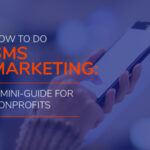Back-to-School Marketing: How to Reach Your Target Audience

For families with children from preschool to college, the end of the summer marks new beginnings as their kids return to school. Before the school year begins again, parents may run around to different stores, stand in the backpack aisle wondering which option is best for their eighth-grader, or browse the pen and pencil selection online.
Regardless of what type of back-to-school product you sell, it’s your job as a marketer to help potential customers wade through the never-ending options out there to find your company and make a purchase. In this guide, we’ll provide tips for how you can launch successful, data-driven back-to-school marketing campaigns that reach (and convert) your target audience.
1. Conduct a data append.
Start by looking through your customer relationship management (CRM) system to identify current customers who may be interested in back-to-school campaigns. These may be frequent buyers or people who typically purchase from your business during this time of year.
You may notice you’re missing some key information about these customers that would help you better reach them. To fill in these gaps, work with a data provider to conduct a data append.
A data append involves supplementing your current customer data with additional information from third-party sources. This data can help you better understand your customers and ensure they receive your marketing communications.
The types of data you can acquire through a data append include:
- Demographics, like name and age
- Contact information
- Education
- Presence of children in the home
- Income
- Net worth
- Lifestyle information
In the case of a back-to-school campaign, determining which of your customers have children living at home can help you narrow down your target audience. This way, you’ll only send back-to-school communications to those who have students they need to make purchases for. Additionally, you may append different types of contact information—such as phone numbers and email addresses—to reach as many customers as possible through these channels.
2. Leverage student marketing data.
Once you’ve rounded out your CRM through a data append, consider whether you have enough customer information to reach your intended audience. While your current customer data may provide a great starting point, the more people you can reach, the better.
By leveraging third-party student marketing data, you can expand your reach to even more people who are likely to engage with your back-to-school campaigns. For example, Deep Sync’s student marketing data guide explains how one of their clients used their student marketing data to “increase exposure among back-to-school shoppers” by targeting college students and their parents.
Once you obtain this data, you can activate it across online and offline channels, including direct mail, email, and social media. With access to 14 million postal addresses and 8.4 million digital and social records, the client mentioned above was able to dramatically expand their reach, increasing both website traffic and online orders.
To maximize the effectiveness of your student marketing data, segment your audience based on characteristics that will help you push your goals forward. For instance, if you’re looking to reach both students and their parents, you may group potential customer records based on age. To get even more granular, you can segment students based on grade level and target them with products they’re most likely to be interested in based on their school year.
3. Optimize your website.
With the foundation of your data-driven marketing efforts squared away, it’s time to launch your strategy. Your website is the hub for all important information about your business, so you should ensure it’s easily accessible, mobile-friendly, and filled with informative content.
Ways to enhance your website to better promote your back-to-school campaign include:
- Prioritizing search engine optimization (SEO). SEO refers to the process of optimizing your website so it appears higher in search engine results. One of the key elements of a cohesive SEO strategy is choosing relevant keywords your audience may search for and incorporating them throughout your site. That way, your business will show up for relevant search results. For example, a clothing store running a back-to-school campaign may create a page on its website that’s optimized for the keyword “back-to-school clothes for teens” to target an audience of high school students.
- Creating blog content. Building a blog on your website can bring in new customers by first answering their questions or providing useful information. Then, they may explore your website further and make a purchase. To move them through the sales funnel, include calls to action on your blog posts that link to relevant product pages or your back-to-school campaign page. For instance, a backpack retailer may create a blog post entitled “Top 10 Backpack Essentials: What Your Student Should Pack” and link to a page featuring their latest backpack line.
- Improving website navigation. Make it easy for customers to find what they’re looking for to make their final purchase by featuring intuitive navigation on your site. Use a main navigation menu with clear labels, and include a search bar so users can easily pinpoint specific pages, content, or products they have in mind.
Considering about 76% of adults purchase items using their phones, it’s also important to ensure your website is optimized for mobile devices. Choose a website builder that allows you to create a responsive design, and ensure the text and buttons on each page are large enough for people on smaller devices to read and press.
4. Run social media campaigns.
Use your customer data or segments to run targeted social media campaigns on platforms like Instagram, Facebook, and TikTok. You may create audience personas for different segments to drive your efforts, such as parents, students, and even educators themselves.
Then, brainstorm a content strategy that engages different members of your audience on social media. To get you started, here are a few ideas:
- Giveaways and contests. Have your social media followers post back-to-school-related images with a unique hashtag for the chance to win a prize, such as school supplies or a gift card to your business.
- Countdown to school. Share back-to-school tips and product highlights each day to count down to the start of the school year. For instance, you may show off your new line of pencil cases or provide tips on how to host the best back-to-school night.
- Polls and quizzes. Ask your followers back-to-school-related questions to get them excited about the new school year. What are parents packing in their children’s lunches? What are the top study tips that students plan to follow this semester?
- Influencer partnerships. Try working with an influencer who resonates with your target audience to promote your products on social media. For example, you may reach out to a mother of three children who posts content on TikTok about raising her kids to appeal to your audience of parents.
Once you launch your social media campaigns, measure their success by tracking metrics like impressions, likes, comments, and shares.
5. Promote discounts and loyalty programs.
Discounts can get a customer’s foot in the door while loyalty programs can help them stay. Develop thoughtful back-to-school discounts that bring in new customers and loyalty initiatives that keep them around past the back-to-school season. Then, run email marketing campaigns informing customers of these perks and incorporating calls to action to emphasize urgency and inspire action.
Additionally, SMS marketing is a highly effective channel for converting potential customers, with an open rate of over 98%, according to Double the Donation’s digital marketing guide. Use phone number data you’ve collected to reach your audience with current promotions and link to your website to simplify the buying process.
With a comprehensive data-driven marketing strategy, you can tap into your target audience and bring in more business. Remember to incorporate your branding across channels to build brand awareness and help back-to-school customers become long-term advocates of your business.


